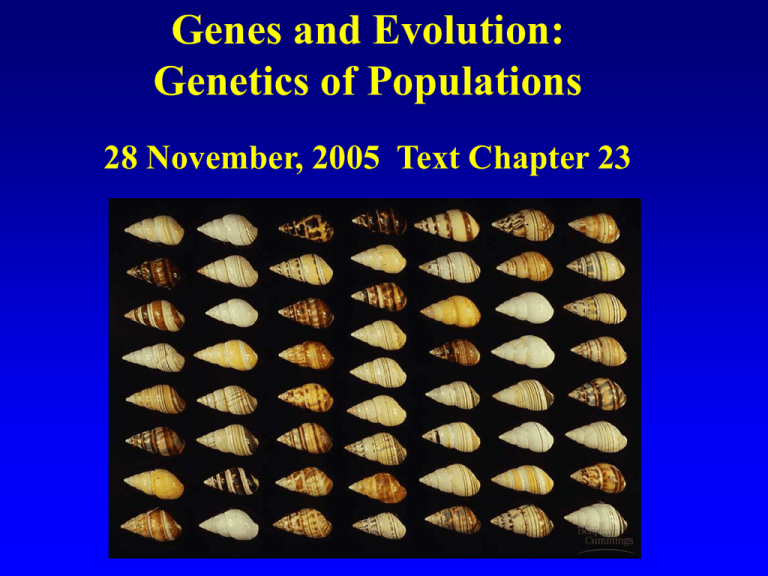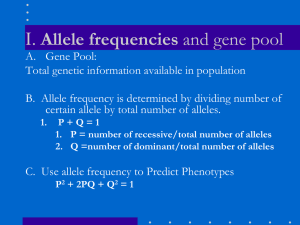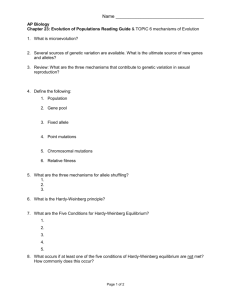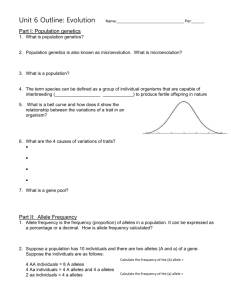Genes and Evolution: Genetics of Populations
advertisement

Genes and Evolution: Genetics of Populations 28 November, 2005 Text Chapter 23 Vocabulary A species is a group of individuals with the potential to interbreed to produce fertile offspring. A population is a localized group of individuals of the same species. The collection of all existing alleles for all genes is the gene pool for the population. Remember that each gene can exist as a number of different alleles. For each gene, the proportion of the total alleles represented by any given allele is the allele frequency for that allele. Allele frequency example. Population: 500 diploid individuals (1000 total alleles for gene A) Gene A : Two possible alleles In our population, A (dominant, pink flowers) a (recessive, white flowers) 20 individuals are aa 160 individuals are Aa 320 individuals are AA The allele frequency for A is ((320)(2)+160)/1000 = 800/1000 = .8 The allele frequency for a is ((20)(2)+160)/1000 = 200/1000 = 0.2 For an idealized, sexually reproducing population, these allele frequencies will remain constant over successive generations. If all individuals reproduce to give the same number of offspring, and mating is random, then the allele frequencies in the F1 generation will be the same as the allele frequencies in the parental generation. This is like taking all of the alleles in the population and drawing them two at a time to determine the genotype for each F1 individual. p2 + 2pq + q2 = 1 Hardy-Weinberg Criteria This situation where succeeding generations have the same allele frequencies is called Hardy-Weinberg equilibrium. In order to have no genetic change over time, five conditions must be met. The population must be large. The population must be isolated. Mutations may not occur. Mating must be random. All individuals must have equal reproductive success. If all of these criteria are not met, then the genetic structure of the population will change over time. Microevolution is occurring. The five agents of microevolution, genetic drift, gene flow, mutation, sexual selection, and natural selection represent departure from the five conditions for equilibrium. Genetic drift is microevolution caused by changes in the gene pool of a small population due to chance. Population bottlenecks are an example of genetic drift. The founder effect is a related agent of genetic change. Gene flow occurs when a population gains or loses alleles in exchange with another population. This effect tends to reduce genetic differences between populations that were previously isolated. Mutation (heritable changes to DNA occur constantly in every cell of every individual. In humans, a mutation rate of about 1 per locus per 1,000,000 gametes is typical. Mutation cannot lead to large changes in allele frequency unless it is accompanied by selection. Selection can take the form of nonrandom mating, or Unequal reproductive success (natural selection). Of all of the agents of microevolution, only natural selection is adaptive. Genetic variation, the substrate for selection, occurs both within and between populations. In Drosophila populations, about 30% of loci have more than one allele, and each fly is heterozygous at about 12% of its genes. Variation between populations is even greater. Diploidy and Balanced Polymorphism Preserve Variation. Frequency-dependent Selection Selection may be stabilizing, directional, or disruptive. Sexual Reproduction is Disadvantageous.




